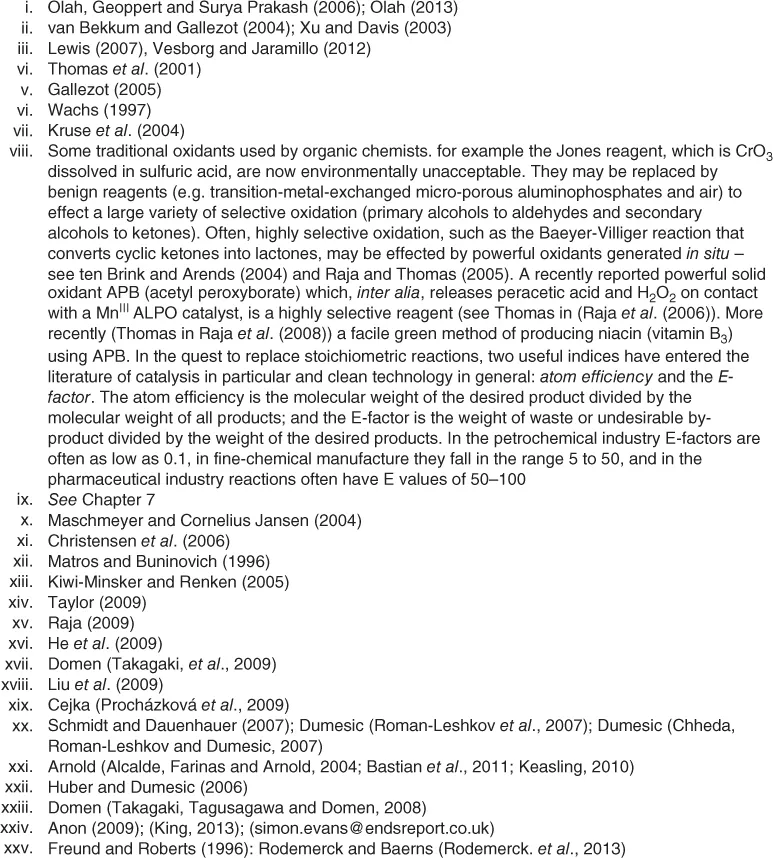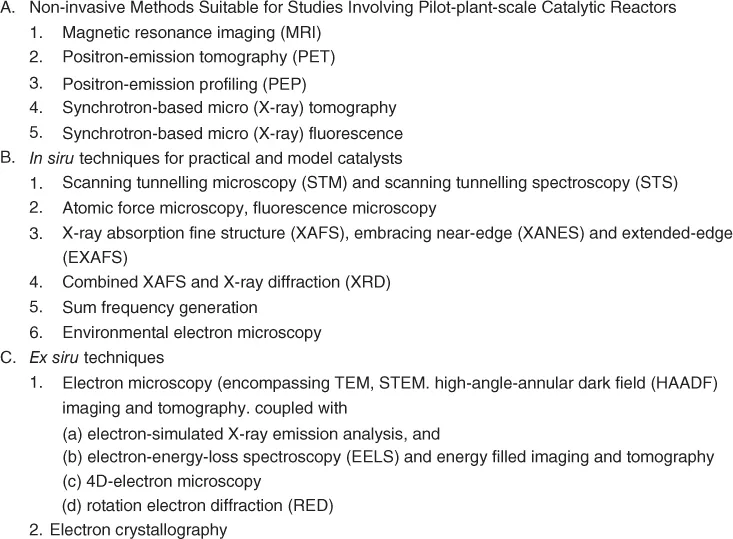
eBook - ePub
Principles and Practice of Heterogeneous Catalysis
John Meurig Thomas, W. John Thomas
This is a test
Compartir libro
- English
- ePUB (apto para móviles)
- Disponible en iOS y Android
eBook - ePub
Principles and Practice of Heterogeneous Catalysis
John Meurig Thomas, W. John Thomas
Detalles del libro
Vista previa del libro
Índice
Citas
Información del libro
This long-awaited second edition of the successful introduction to the fundamentals of heterogeneous catalysis is now completely revised and updated.
Written by internationally acclaimed experts, this textbook includes fundamentals of adsorption, characterizing catalysts and their surfaces, the significance of pore structure and surface area, solid-state and surface chemistry, poisoning, promotion, deactivation and selectivity of catalysts, as well as catalytic process engineering. A final section provides a number of examples and case histories.
With its color and numerous graphics plus references to help readers to easily find further reading, this is a pivotal work for an understanding of the principles involved.
Preguntas frecuentes
¿Cómo cancelo mi suscripción?
¿Cómo descargo los libros?
Por el momento, todos nuestros libros ePub adaptables a dispositivos móviles se pueden descargar a través de la aplicación. La mayor parte de nuestros PDF también se puede descargar y ya estamos trabajando para que el resto también sea descargable. Obtén más información aquí.
¿En qué se diferencian los planes de precios?
Ambos planes te permiten acceder por completo a la biblioteca y a todas las funciones de Perlego. Las únicas diferencias son el precio y el período de suscripción: con el plan anual ahorrarás en torno a un 30 % en comparación con 12 meses de un plan mensual.
¿Qué es Perlego?
Somos un servicio de suscripción de libros de texto en línea que te permite acceder a toda una biblioteca en línea por menos de lo que cuesta un libro al mes. Con más de un millón de libros sobre más de 1000 categorías, ¡tenemos todo lo que necesitas! Obtén más información aquí.
¿Perlego ofrece la función de texto a voz?
Busca el símbolo de lectura en voz alta en tu próximo libro para ver si puedes escucharlo. La herramienta de lectura en voz alta lee el texto en voz alta por ti, resaltando el texto a medida que se lee. Puedes pausarla, acelerarla y ralentizarla. Obtén más información aquí.
¿Es Principles and Practice of Heterogeneous Catalysis un PDF/ePUB en línea?
Sí, puedes acceder a Principles and Practice of Heterogeneous Catalysis de John Meurig Thomas, W. John Thomas en formato PDF o ePUB, así como a otros libros populares de Physical Sciences y Organic Chemistry. Tenemos más de un millón de libros disponibles en nuestro catálogo para que explores.
Información
1
Setting the Scene
This chapter falls into two unequal parts. First, there is an extended prologue which highlights (partly in tabular form) several important developments that have occurred in heterogeneous catalysis since the mid-1990s. Second, there follows (seriatim), with certain updated items and some omissions, the sequence of topics that were covered in Chapter 1 of the first edition.
1.1 Prologue: Advances since the Early 1990s
Apart from recent significant advances arising from the emergence of new experimental and theoretical techniques, many profound changes have occurred owing to a variety of both external and internal factors. Some external factors (Figure 1.1) are of a practical nature; many are of a societal-cum-cultural kind. In response to recent global trends of a political, legislative and environmental nature, the past decade has witnessed the arrival of new areas of scientific exploration that demand the development of new catalysts, particularly those capable of being recycled and/or reactivated.


Figure 1.1 External factors that impinge upon the use and development of new solid catalysts.
In addition, we continually see the key role that internal factors – those that stem from the development of powerful new techniques of investigation (see Figure 1.2) – exert upon modern heterogeneous catalysis. Thus, quite dramatic discoveries have recently been made concerning the mode of operation of noble metal catalysts under working conditions, and these have already led to an overthrow or a re-examination of earlier descriptions and theories about the surface reactions on such ostensibly simple catalysts (e.g. palladium and platinum in their putative role in facilitating the oxidation of CO to CO2). It transpires (see Hendriksen (Hendriksen, Bobaru and Frenken, 2004)) that, contrary to what experiments conducted with ultra-high vacuum equipment had led us to believe, under atmospheric pressure of reactant gases (as in an auto-exhaust catalytic system) the metal surface has a veneer of a PdO or a PtO2 phase and this catalyses the oxidation of CO to CO2 by the classic sacrificial (Mars–van Krevelen) mechanism (see Figure 1.22 below), and not the long-assumed Langmuir–Hinshelwood one (Figure 2.1). In other words this important catalytic reaction (of vital concern in environmental protection) proceeds by utilization of structural oxygen from the surface oxide, not by interaction of adsorbed oxygen and CO at the exterior surface of the metal.

Figure 1.2 A selection of some of the powerful new techniques available for the non-invasive or in situ study of solid catalysts.
Several other internal factors have exerted their impact, notably the deployment of other new tools and techniques of an experimental nature, and the now almost routine recruitment of computational and modelling approaches utilizing density functional theory (DFT), molecular dynamics and variants thereof. These will be discussed in later chapters. Furthermore, there are sound reasons for believing that widely applicable strategies exist for the design of new heterogeneous catalysts based, paradoxically perhaps, as much on the precepts of solid-state chemistry as on the lessons learned from surface science. The surface science approach relies heavily on the reductionist view that if all the key factors affecting individual discrete steps – such as rate of adsorption, surface diffusion and reorganization, poisoning at steps and surface desorption – are fully evaluated, one ought to be better placed to design superior catalysts. There are indeed some striking increases, registered by Nørskov, Besenbacher and their Danish colleagues, where the reductionist approach centred on scanning tunnelling microscopy (STM) has led to the design of viable, industrially important new (or improved) catalysts. But, in practice, it is not usually the reductionist argument, but the so-called ‘emergent’ one (which brings together all the relevant quantitative and intuitive factors and which is at the heart of the solid-state chemist's lines of argument) that succeeds in arriving at altogether new catalysts. The large, and ever-growing, class of single-site heterogeneous catalysts (SSHCs described later) testify to the validity of this view, and has led to the confluence of heterogeneous and homogeneous catalysis.
Another noteworthy chemical engineering trend is the use of micro-kinetic modelling procedures. In addition, it is a feature of present-day catalyst practice that the chemical and control-engineers who use robotic devices and a diversity of programmed logic controls as well as finite-element-analyses packages, can nowadays set up precisely arranged catalytic reactors fine-tuned to maximize efficiency of chemical production.
Before we proceed to elaborate the nature of these extern...